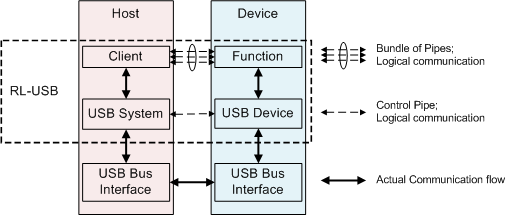|
||
| Products Download Events Support Videos | ||
Technical Support
On-Line Manuals
RL-ARM User's Guide (MDK v4)


 Basic Communication Model
Basic Communication Model
The host and the device have distinct layers, as shown in the picture below. Ultimately, the communication occurs on the physical USB wire. However, there are logical host-device interfaces between each horizontal layer.
The major host layers are the:
- Client describing the software entities responsible for interacting directly with USB devices.
- USB System managing data transfers between the host and USB devices.
- USB Bus Interface handling interactions of the electrical and protocol layers and actually transmits the packets.
Host layers have the role to:
- Detect the attachment and removal of USB devices.
- Manage USB control flows between the host and USB devices.
- Manage data flows between the host and USB devices.
- Collect status and activity statistics.
- Control the electrical interface.

The major device layers are the:
- Function providing a new capability, for instance, a mouse, a keyboard, an mp3-player, or an ISDN interface.
- USB Device managing data transfers between the host and USB devices.
- USB Bus Interface handling interactions of the electrical and protocol layers and actually transmits the packets.
ProductsDevelopment Tools |
Hardware & Collateral |
Downloads |
Support |
Contact |
